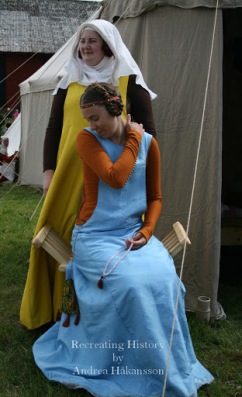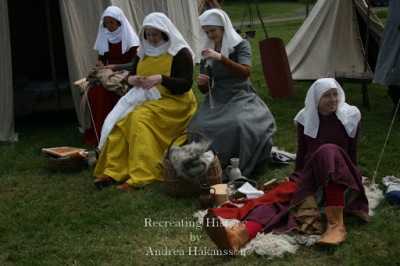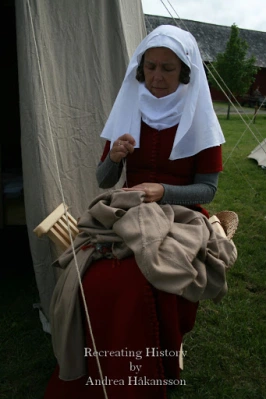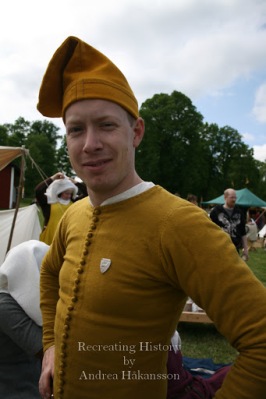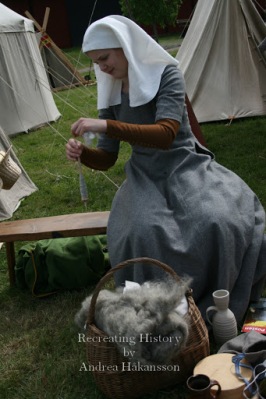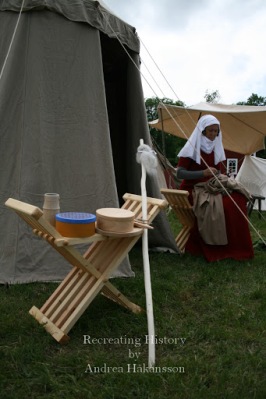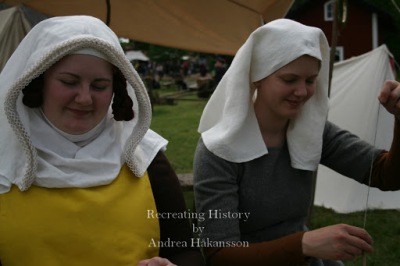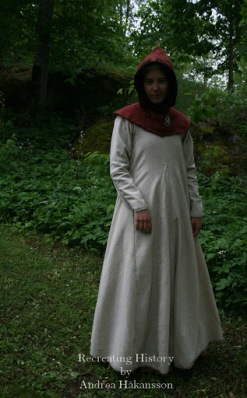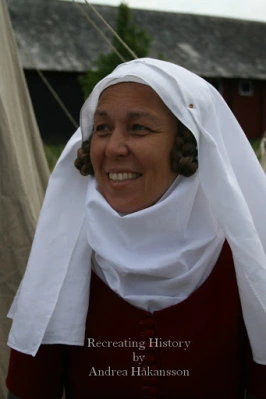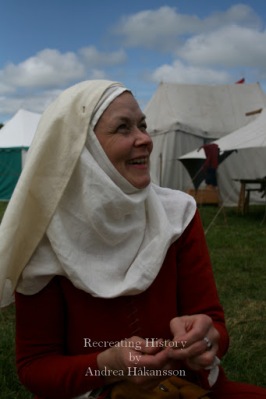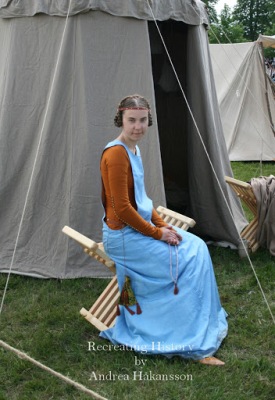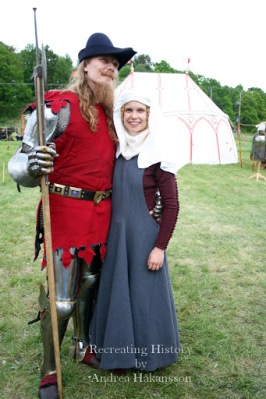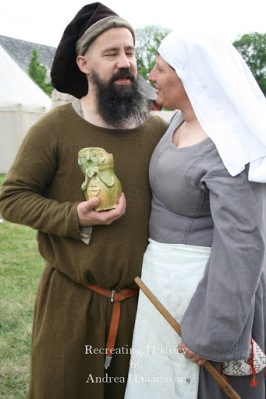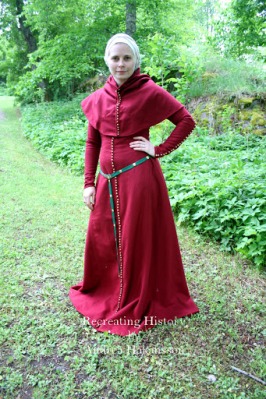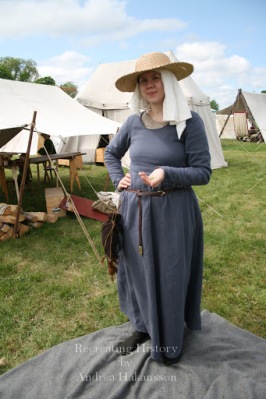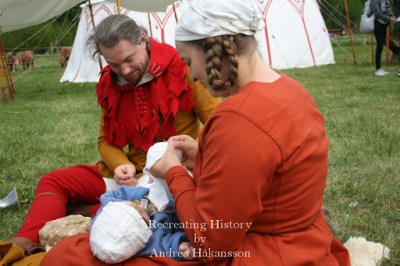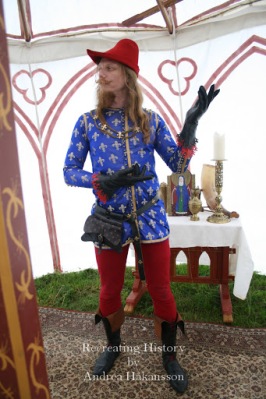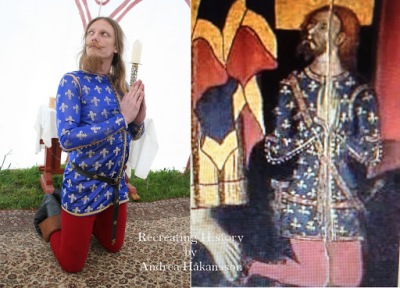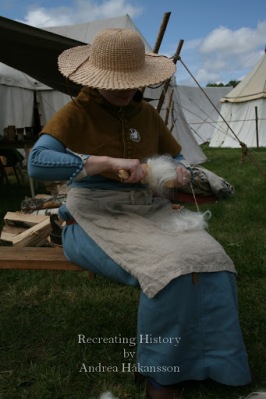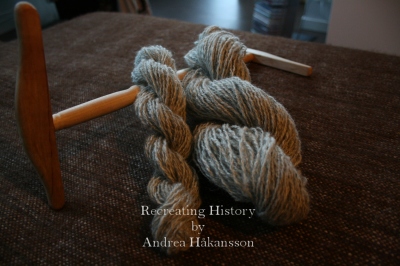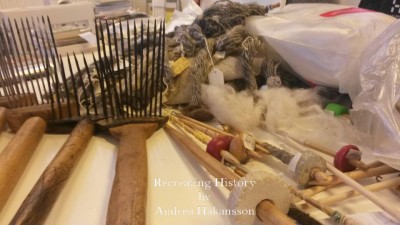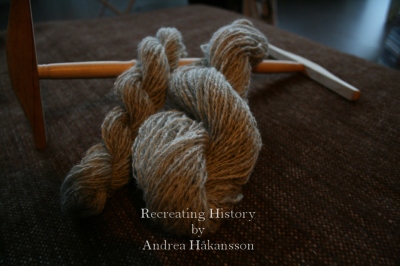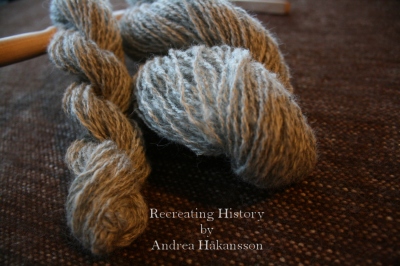Det här inlägget är främst till för att samla den forskning jag har gjort inför sömnaden av mitt Herjolfsnesutmaningsplagg. Jag listar de steg och ämnen som jag har funderat över, och skriver om mina fynd och slutsatser. Artikeln fokuserar främst på plagget med museumnummer D10584, eller också Nörlund nummer 42, men jag jämför även det med de andra plaggen från Herjolfsnes och andra plagg från medeltida Europa. Jag kommer använda följande förkortningar för olika böcker jag tittat i. SSTJ står för Som syet till jorden (den danska originalversionen, den engelska översättningen heter Woven into the Earth) och MGR för Medieval garments reconstructed. När jag citerar Östergård gör jag det på engelska och därför, vilket kanske är lätt förvirrande, hänvisar jag till den engelska översättningen, alltså Woven into the Earth, och sidhänvisningarna är alltså till den engelska versionen.
This post will mainly gather the research I’ve made prior to sewing my Herjolfsnes Challenge-garment. I list the stages and cathegories I’ve given thougt, and write about my findings and conclusions. The post focuses on the garment with museum number D10584, or Nörlund no 42, but I will also correlate it to the other Herjolfsnes garments and to extant medieval garments found around Europe. I will use SSTJ as short for Som syet til jorden (the original, Danish, version of Woven into the Earth) and MGR for Medieval garments reconstructed. When I cite Östergård I do so from the translated version of SSTJ, i.e. Woven into the Earth, and the page numbers will refer to that, English, version.
 |
| D10584, or Nörlund no 42. Photo from kostym.cz |
Vad står skrivet?
D10584 är en plagg av Nörlund typ Ib, “which are tight-fitting with gussets inserted in the front and back and with between four and eight side pieces which give them outward-flaring fullness from around waist height. The garments are for pulling over the head, with round or oval neck openings.” (Östergård, 2004, p 128). Andra Grönlandsplagg som tillhör typ Ib är D10580, D10581, D10582 och D10583.
Plagget ansågs vara en herrkjortel enligt Nörlund, baserat på placeringen av fickslitsarna i förhållande till låret. Den slutsatsen är ganska spekulativ enligt mig – varför skulle en lägre placerad fickslits indikera att det är ett herrplagg? Det enda sättet att få ett definitivt svar skulle varit om plagget hittades på en kropp, alltså buret av personen när den begravdes. Då skulle det vara möjligt att göra en osteologisk analys av skelettet för att bestämma könet på individen, och inte ens då skulle resultatet vara helt säkert.
What is written?
D10584 is a Nörlund type Ib, “which are tight-fitting with gussets inserted in the front and back and with between four and eight side pieces which give them outward-flaring fullness from around waist height. The garments are for pulling over the head, with round or oval neck openings.” (Östergård, 2004, p 128). Other garments that belong in the type Ib cathegory are D10580, D10581, D10852 and D10583.
It was considered a mans kirtle by Nörlund, based on the location of the pocket slits in relation to the thigh. This is rather speculative in my opinion – why would a lower pocket slit indicate that it’s a mans garment? The only way to get a definite answer to wheter it’s a man’s or a woman’s garmet would be to find the garment on the body, worn by the person. Then it would be possible to do an osteological analysis of the skeleton to determine the sex of the individual and not even then the result would be a hundred percent certain.
Som det är nu så hittades plaggen inte burna av personerna i gravarna, utan de hade använts som liksvepningar. Det innebär att det inte ens är säkert att de egentligen tillhörde personerna de gravlagdes med, vilket i sin tur innebär att en analys av kvarlevorna inte ger ett svar på huruvida plagget tillhörde en man eller en kvinna. Man skulle förstås kunna jämföra de olika plagglängderna och sedan säga något om de resultaten, men för att det skulle ge något definitivt skulle man också behöva göra en studie av medellängden hos kvinnor och män i Herjolfsnes och först då skulle man kunna säga något om vad som var en “kvinnlig längd” och “manlig längd” på kläderna. Det är inte en analys jag varken haft tid eller möjlighet att göra, men det är såklart ett väldigt intressant ämne. Det är fullt möjligt att en liknande analys redan gjorts, så om någon vet var man kan hitta det så får ni gärna höra av er – jag skulle vara mycket intresserad av att forska mer kring det. Utöver detta skriver också Östergård att omkretsen vid både handled och ärmhål på plagget är väldigt liten, vilket talar emot Nörlunds slutsats om att det skulle vara ett herrplagg, och det leder henne till att tro att det snarare är ett kvinnoplagg.
Min slutsats är att det är svårt att säga om D10584 är ett kvinno- eller mansplagg, men i slutändan spelar det ingen större roll. Min version kommer bli ett kvinnoplagg till mig själv. Även om det i framtiden framkommer starkare bevis för att det är ett mansplagg så är det fortfarande en trovärdig tolkning av ett kvinnoplagg från samma tid.
As it is now, the garments were found as wrappings for the bodies and not worn. That means that it isn’t even certain that they belonged to the person they were buried with, which means that analysing the human remains does not give an answer to wheter the garments belonged to men or women. You could of course compare the lenght of the garments and then say something about those results, but then you would have to compare that to the average heights of the men and women of Herjolfsnes and then decide what is a “female lenght” and what is a “male lenght” of a garment. That is not something I have bothered to do, but it would indeed be an interesting topic if anyone would have the time to do it. Perhaps it has already been done, or at least something similar? I would be interested to know, so if someone knows about it, please send me a message so I could investigate. Östergård also writes that the wrist diameter and armscye are both small, which speaks against Nörlunds conclusion that it is a man’s garment, and leads her to think that it’s rather a woman’s garment.
My conclusion is that it is hard to say if the D10584 is a woman’s or a man’s garment, but in the end it doesn’t really matter. My version will be a woman’s garment for myself. Even if there will be stronger evidence in the future suggesting that it indeed is a man’s garment, it will still be a very plausible interpretation for a woman’s garment of the same time.
 |
| Some of my needles and a piece of combed Rya wool |
D10584 har inte blivit C14-daterat, men ett annat plagg tillhörande samma typ (typ Ib) blev daterat till 1380-1530 (med en peak mellan 1400-1480). Dateringen behöver inte nödvändigtvis gälla för alla plagg av samma typ, Ib. Kjortlar av de andra typerna har blivit daterade till främst 1300-tal, både tidigt och sent.
The D10584 have not been carbon dated, but another garment belonging to the same type (type Ib) was dated to 1380-1530 (with a peak between 1400-1480). The dating does not have to extend to all of the garments of type Ib. Kirtles in the other cathegories are dated to mainly 14th century – both early and late.
Sömmar, tråd och tyg
Det står egentligen inte så mycket skrivet om sömmarna som användes för att sy D10584. Beskrivningen av sömmarna som användes i D10581 och D10579 är mycket mer ingående. I SSTJ så finns det ett helt kapitel som handlar om sömnadsteknikerna som användes på Grönlandsplaggen, och när sömmar specifieras i plaggbeskrivningarna så verkar de skilja sig från dessa generella beskrivningar. Det leder mig till att anta att om sömnadsteknikerna inte specifieras i plaggbeskrivningen så är de gjorda enligt den allmäna beskrivningen. På grund av det kommer jag använda mig av de sömmar som talas om i den generella genomgången (se citat nedan). Jag kommer att fälla sömmarna åt samma håll, utom i axelsömmarna eftersom Östergård i SSTJ skriver att dessa normalt fälldes åt varsitt håll.
Seams, thread and fabric
There is not much written about the actual seams that made up the D10584. The description of the seams of the D10581 and D10579 are way more elaborate. In SSTJ there is a whole chapter describing the sewing techniques used on the Greenland garments, and when seams are specified in the garment descriptions they seem to differ from the over-all description. That leads me to think that if the sewing techniques are not specified, they were sewn as described in the beginning of SSTJ. Because of that I will use the seams described in the over-all description (see citation below). I will fell the seams to one side in all seams except for the shoulder seam, since SSTJ states that those commonly were split and felled.
“Many of the seams may have been done from the front, where one piece with a fold along the cut-off edge has been laid in over the adjacent piece. In these seams a hem stitch has been used. The seam allowance on the back is fastened in one piece to one side with tight overcast stitching down to the cloth.” Östergård 2004, page 98
Sytråden som användes beskrivs som tunn och tvåtrådig, spunnen av kammad får- eller getull. Den är Z-spunnen och S-tvinnad, och diametern är ungefär 1 mm. Till det här projektet har jag spunnit min egen sytråd av handkammad ryaull och spunnit den med en reproduktion av en medeltida slända tillsammans med mitt fiberfäste/spinnpinne.
The sewing thread is described as a thin, two-ply, thread, spun from combed sheep’s or goat’s wool. It is Z-spun and S-plied, and the diameter is about 1 mm in diameter. For this project I’ve spun my own sewing thread, made from handcombed Rya wool (Rya is a Swedish breed of sheep). I’ve spun it with a medieval spindle replica together with at distaff.
 |
| The sewing thread |
Enligt SSTJ är tyget i D10584 en 2/2-kypert. Originalfärgen på tyget var brunt, och i tabellen om färg och tråd i MGR så skriver de att varpen var tannin (färgad?) brun och inslaget mörkbrunt. I somras köpte jag ett ekologiskt ulltyg från Medeltidsmode, ett tvåfärgat tyg med olika, naturliga fårfärger, i varp och inslag, med tanken att det skulle bli ett Herjolfsnesplagg. Senare insåg vi att vi är hyfsat många som köpt samma tyg med samma intention, så kommande sommar i Visby kommer vara “all about” Grönlandsmode. Många av tygerna i Herjolfsnes har fler trådar i inslag än varp per centimeter. Mitt har det inte.
According to SSTJ the fabric D10584 is sewn in is a 2/2-twill. The original colour of the fabric was brown, and in the table about colour and thread in MGR states that the warp is a tannin (dyed?) brown. and the weft is dark brown. Last summer I bought an ecological wool from Medeltidsmode, bi-coloured in natural shades of the sheep, with the intent for it to become a Herjolfsnes garment. Later, we realised that we were several people that bought the same fabric with the same intent, so next year in Visby will be all Greenland fashion. Many of the textiles in Herjolfsnes are weft-faced. My fabric is not.
 |
| The fabric (in bad lightning). It’s lighter in real life. |
Mönster
När jag har gjort mitt mönster så har jag framförallt gått efter MGR. Mitt plagg, D10584, finns med i den boken. MGR har mönster i tre olika storlekar för varje plagg, men tillsammans med dessa mönster finns även en skiss av hur originalplagget ser ut i förhållande till storlekarna. En stor skillnad från originalplagget mot mitt mönster är att mina ärmar är lika långa. I SSTJ står det att vänster ärm är 530 mm lång och höger ärm är 430 mm lång. Det är väldigt tydligt i det första fotot, längst upp. Totalt kommer mitt plagg bestå av 13 mönsterdelar och en av dem kommer delas ytterligare med en falsk söm.
Pattern
I’ve mainly relied on MGR for the pattern. My garment, the D10584, is drawn in that book. MGR has sizes, but in the pattern diagram they’ve also added the outline of the original garment. One big difference from the original in my pattern is that I’ve made the sleeves the same length. In SSTJ it is written that the left arm is 530 mm long and the right is 430 mm long. This is very much visible in the first photo above. In all, my garment will consist of 13 pattern pieces and one of them will be divided further with a false seam.
 |
| My scaled up pattern on the floor |
Mönstret har redan blivit gjort. Det blev uppskalat från MGR på mönsterpapper, och vi använde storlek S, vilken är mer eller mindre som originalet. Sedan gjordes en toile med hjälp av mönstret, men till mönstret lades även 30 cm längs nederkanten. Allt dettta gjordes med hjälp av min fina mamma, Annette. Toilen passade okej, och med mindre ändringar får jag ett ganska bra mönster.
En av de roligare detaljerna hos det här mönstret är att axelsömmen faller framåt, istället för det man normalt ser – att den sittter mitt på axeln. När jag hade på mig toilen låg axelsömmen precis nedanför nyckelbenet på mig.
The pattern have already been made. It was scaled up from MGR on paper, using the size small, which is more or less the original size. Then a toile was made using that pattern, but with 30 cm added to the bottom hem. All of this was done with the help of my dearest mother, Annette. The toile was an OK fit, and with minor tweaks I would have a perfectly good pattern.
One of the more fun features of the pattern is that the shoulder seam is not at the top of the shoulders, but rather tilted forward. When wearing the toile the seam lies just beneath the collarbone on me.
 |
| Me in the toile. We only had enough fabric for one sleeve. |
Dekorationer och förstärkningar
Runt halshålet och fickslitsarna har en fläta, troligtvis en öglefläta (fingerloop braid) sytts fast. Åtminstone är det den sortens fläta jag drar som slutsats att de har använt efter att ha tittat på bilderna och läst beskrivningen av flätan i SSTJ. Där skriver Östergård att de antagligen flätats med öglor. Garnet jag kommer använda till detta har jag redan spunnit och skrivit om i detta inlägget.
Decoration and reinforcement
The neck opening and pocket slits are finished with a braid, presumably a finger-loop braid. At least that is what I conclude from looking at the image and reading the description of the braid, where Östergård states that they probably were braided using loops. The yarn I will use for these is already spun, and I’ve written about it in this post.
 |
| The yarn I will use for brainds and tablet-weaving |
Samma garn kommer användas till den brickvävda nederkanten. I SSTJ beskrivs denna brickväv ligga ovanpå fållen, och den täcker även en rad med singling. Singling beskrivs också i SSTJ som små förstygn, sydda i S-form längs med fållen för att förstärka den (se illustration).
The same yarn will be used at the tablet-woven piped edging that finishes the bottom hem. The tablet weaving lies on top of the fabric, covering a row of singling, all around the hem. Singling is also described in SSTJ. It is small running stitches, sewn in S-shape along the hem to reinforce it (see illustration).
 |
| Singling |
Längs med nederkanten av ärmarna är det sytt två rader pricksöm. Till dessa kommer jag använda sytråden. De två raderna är sydda längs med fållen och slitsen på ärmen. Det finns också en rad pricksöm längs fickslitsarna, om jag förstår tabellen om sömmar och stygn i MGR korrekt. Antingen menar de fickslitsen eller ärmslitsen, men jag är böjd att tro att det är fickslitsen de menar eftersom Östergård tydligt skriver att både ärmfållen och ärmslitsen har två rader prickstygn. Om någon har den danska versionen av MGR och kan tänka sig att kolla upp vad det står där så hade jag uppskattat det enormt!
There is also some stab-stitching at the end of the sleeves. For these I will use the sewing thread. They are sewn in two rows along the hem and the slit. Also, if I interpret the table on seams and stitching in MGR correctly, there is a single row of stab stitches along the pocket slit. Either that or on the slit of the sleeve, but since SSTJ clearly states that both the hem and the slit of the sleeve have two rows of stab-stitching, I lean to think that it is the pocket slits that have the single row. If anyone have the Danish copy of MGR and could check what it says there for me I would be grateful!
 |
| Stab-stitching on hoods I’ve made |
Andra plagg i Europa
Baserat på det stora antal plagg som troligtvis användes på medeltiden så är det ett väldigt litet urval som överlevt till idag. Ändock har vi ett antal plagg från perioden som kan användas för att ge en bild av hur medeltidsmänniskan var klädd.
Konstruktionsmässigt är Grönlandsplaggen väldigt speciella. Det finns inte riktigt några andra plagg som är gjorda med liknande konstruktion. Endast små detaljer, så som axelsömmens position på D10584, går att hitta hos andra plagg. I det här fallet så går den framflyttade axelsömmen även att finna på Moy-Bog-kjorteln (se Carlson, 2006). Utöver den lilla detaljen så skiljer sig Moy-Bog-kjorteln ganska ordentligt från Grönlandsplaggen.
Other garments around Europe
Based on the amount of garments that probably were used in the medieval times, the ones that have survived to today are very few. Non the less, we have some garments from the period that can be used to give a hint about how the medival people dressed.
The Greenland garments are very special construction wise. There are not really any other garments from the period that are similar in construction. Only small features, such as the position of the shoulder seam on the D10584, can be seen in other garments. In this case the forwarded shoulder seam can also be found in the Moy Bog garment (see Carlson, 2006). Other than that, the Moy Bog garment differs a lot from the Greenland garments.
 |
| Difference in warp placement for tablet-woven edges. |
Kantvävning med brickor kan man hitta på många ställen, men genomförandet skiljer sig något från plats till plats. Här tänker jag framförallt på kantvävningen på textilierna från London – specifikt den ärmkant som blivit kantvävd vid knapphålen. När den beskrivs i Textiles and Clothing så verkar det som att kantväven ligger utanpå kanten. Kantväven på Grönlandsplaggen ligger snarare ovanpå kanten – en skillnad jag försökt illustrera ovan.
Tygerna från Herjolfsnes är nästan alla 2/2-kypert. I Europa under samma tid är de vanligaste bindningarna 2/1-kypert och tuskaft.
Tablet-woven edges can be seen in more than one places, but the execution of it differs from piece to piece. Here I am thinking mainly of the tablet-woven edges in the textiles from London – specifically the edge of a sleeve with button-holes. When decribed in Textiles and Clothing the edge seem to be just that – an egde. The tablet-weaving on the Greenland garments rather lies on top of the edge. I’ve tried to illustrate the difference above.
The fabrics found in Herjolfsnes are almost all in 2/2-twill. In Europe at the same time, the most common weaves are 2/1-twill and tabby.
Kommande steg
Nu är nästa steg att klippa ut delarna ur tyget – något jag trodde att jag skulle ha gjort vid det här laget, men vardagslivet har hängt mig i hasorna och jag har fått prioritera annat. Jag har också lärt mig att sticka strumpor, vilket jag trodde att jag aldrig skulle lära mig. Det innebär att jag övar på den färdigheten ganska mycket. Men! Snart kommer jag ta mig samman och klippa ut och börja sy, för egentligen kan jag inte bärga mig!
Next steps
Now I need to cut the fabric. I thought I would have done that by now, but everyday life have caught up with me and I’ve had to prioritise other things. Also, I’ve learnt how to knit socks, which I never thought I would. That means that I’m practicing that skill quite a lot. But! Soon I will bring myself together to cut the fabric and start sewing, because I can’t wait, really!
 |
| My first ever knitted socks! Tiny ones, but still |
References
Carlson, I. M. (2006). Some Clothing of the Middle Ages,
http://www.personal.utulsa.edu/~marc-carlson/cloth/bockhome.html
Crowfoot, E., Pritchard, F., & Staniland, K. (2006). Textiles and Clothing, c. 1150-c. 1450 (Vol. 4). Boydell Press.
Fransen, L., Nørgaard, A., & Østergård, E. (2011). Medieval garments reconstructed: Norse clothing patterns. Aarhus Universitetsforlag.
Østergård, E. (2004). Woven into the earth: textiles from Norse Greenland. Aarhus Universitetsforlag.






















